CDL Practice Tests: Flatbed Cargo Securement
Choose A Section:
Go!When securing building materials, how many tiedowns are required for top tier bundles longer than 5 ft?
- 1
- 0
- It depends on weight
- 2
Tiedowns over the top tier of bundles with a minimum of 2 tiedowns over each top bundle longer than 1.52 m (5 ft).
When securing heavy vehicles, what is the minimum WLL of each tiedown?
- 10,000 lbs
- 5,000 lbs
- 2,268 lbs
- 50% of the weight of the cargo
- Restrain cargo using a minimum of four tiedowns, each having a WLL of at least 2,268 kg (5,000 lb.).
Load securement for cargo weighing 29,650 lbs must be able to withstand upward force of how many lbs?
- 14,825 lbs
- 29,650 lbs
- 30,000 lbs
- 5,930 lbs
How strong must the vehicle structure and anchor points be?
All elements of the vehicle structure and anchor points must be strong enough to withstand the forces described on page 7.
- Forward force: 0.8 g (80%)
- Rearward force: 0.5.g (50%)
- Sideways force: 0.5 g (50%)
- Upward force: 0.2 g (20%)
When banding paper rolls with eyes vertical, you should:
- Secure bands with tape, hangers, or other means.
- Spread rolls apart from each other.
- Apply bands loosely.
- All of these are necessary.
Banding
If paper rolls are banded together:
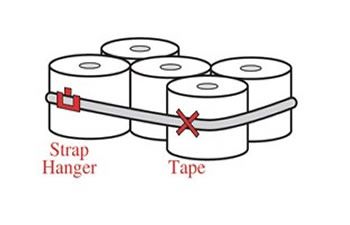
- Place rolls tightly against each other to form a stable group.
- Apply bands tightly.
- Secure bands with tape, hangers, or other means so that the bands cannot fall off the rolls or slide down to the deck.
Option #1 for securing coils transported with eyes lengthwise includes:
- It should include all of these things
- Using blocking or friction mats to prevent forward movement.
- Attaching at least one tiedown diagonally from the left side of the vehicle, through the eye, to the right side of the vehicle
- Attaching at least one tiedown diagonally from the right side of the vehicle, through the eye, to the left side of the vehicle
Tiedowns, Single Coil Option #1
Attach at least one tiedown diagonally from the left side of the vehicle, through the eye, to the right side of the vehicle. If possible, the angle between the tiedown and the deck should be less than 45, when viewed from the side of the vehicle.
Attach at least one tiedown diagonally from the right side of the vehicle, through the eye, to the left side of the vehicle. If possible, the angle between the tiedown and the deck should be less than 45, when viewed from the side of the vehicle.
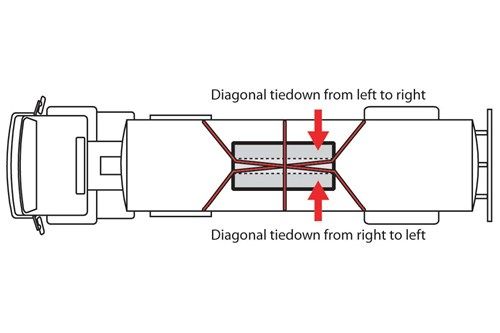
Attach at least one tiedown side-to-side over the top of the coil.
Use blocking or friction mats to prevent forward movement.
What is the maximum weight that can be secured by a tiedown with a marked WLL of 5,000 lbs?
- 5,000 lbs
- 6,000 lbs
- 10,000 lbs
- 2,500 lbs
Note: The minimum WLL requirement for the securement system is 50%. More tiedown capacity should be used if you need to secure an article against any movement.
The Aggregate Working Load Limit should, at minimum, be:
- 50% of the weight of the cargo.
- 80% of the weight of the cargo.
- 100% of the weight of the cargo.
- Determined by the shipper.
How much should the Aggregate Working Load Limit be?
The aggregate working load limit of any securement system must be at least 50% of the weight of the cargo being secured.
If the cargo is fully contained in a sided vehicle, what is the minimum requirement for withstanding sideways force?
- 0.7g (70% of cargo weight)
- 0.2g (20% of cargo weight)
- 0.8g (80% of cargo weight)
- 0.5g (50% of cargo weight)
Note: If the cargo is contained in a sided vehicle, the vehicle structure MUST be strong enough to withstand the forces described earlier.
- Forward force: 0.8 g (80%)
- Rearward force: 0.5.g (50%)
- Sideways force: 0.5 g (50%)
Specific securement methods are required for boulders that:
- Have more than five distinct sides.
- Weigh more than 5,000 lbs, or have a volume of more than 4 cubic meters.
- Weigh more than 11,000 lbs, or have a volume of more than 2 cubic meters.
- Weigh more than 5,000 lbs, or have a volume of more than 1.25 cubic meters.
The requirements in this section apply to any piece of natural, irregularly shaped rock that:
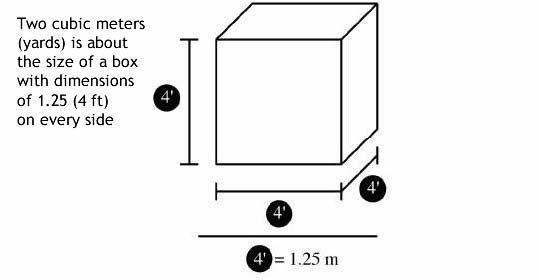
Weighs more than 5,000 kg (11,000 lb.) or has a volume greater than two cubic meters
Is transported on an open vehicle or in a vehicle whose sides are not designed and rated for the transportation of boulders.
All of these are requirements for securing longwood lengthwise except:
- Each end of the log should extend at least 3 inches beyond the stakes.
- Secure each log with at least two tiedowns if shorter logs are carried on top of the stack.
- Each outside log should bear against at least two stakes, one near each end of the log.
- Must be cradled in two or more bunks or contained by stakes.
Requirements for securing longwood loaded lengthwise
- Longwood must be cradled in two or more bunks or contained by stakes.
- Each outside log should bear against at least two stakes, one near each end of the log.
- Each end of the log should extend at least 0.15 m (6 in) beyond the stakes.
- If shorter logs are carried on top of the stack, secure each log with at least two tiedowns.
About The Flatbed Cargo Securement CDL Manual
Studying the flatbed cargo securement CDL manual is not a requirement for getting your CDL permit or license. It is required knowledge for flatbed drivers.
Some questions you should be able to answer for flatbed cargo securement:
- What is the minimum Working Load Limit of a tiedown used to secure logs?
- What is the minimum weight of a shipment of paper rolls that would require specific securement requirements?
- When securing concrete pipe over 45 inches loaded crosswise, which direction must the tiedowns on the front half of the load run?
- What is a cab shield?
- When securing concrete pipe over 45 inches loaded crosswise, which direction must the tiedowns on the rear half of the load run?
- What is a dunnage bag?
- Who is responsible for inspecting securing devices and cargo within the first 50 miles?
- How many tiedowns are required on a stack of shortwood loaded crosswise?
- What is the minimum working load limit of each tiedown used to secure crushed or flattened vehicles?
- Define 'bolster'
- What is a hook-lift container?
- When a tiedown is attached directly to the cargo, what is the ideal angle where it attached to the vehicle?
What is a securing device?
Any device specifically manufactured to attach or secure cargo to a vehicle or trailer:
- Synthetic Webbing
- Chain
- Wire rope
- Manila rope
- Synthetic rope
- Steel strapping
- Clamps and latches
- Blocking
- Front-end structure
- Grab hooks
- Binders
- Shackles
- Winches
- Stake pockets
- D-rings
- Webbing ratchet
- Bracing
- Friction mat
What is a tiedown?
A combination of securing devices that forms an assembly that:
- Attaches cargo to, or restrains cargo on a vehicle.
- Is attached to anchor point(s).
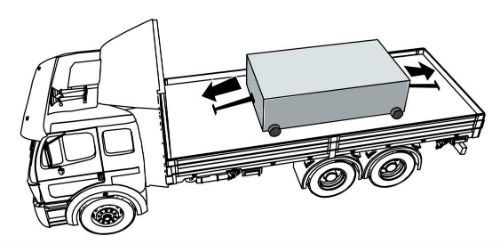
Some tiedowns are attached to the cargo and provide direct resistance to restrain the cargo from movement.
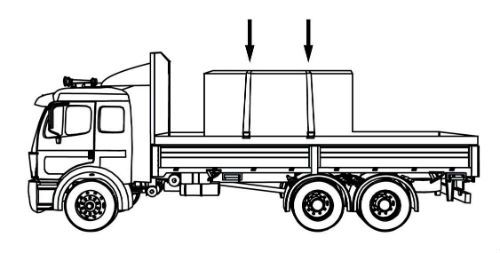
Some tie-downs pass over or through the cargo. They create a downward force that increases the effect of friction between the cargo and the deck. This friction restrains the cargo.
 Related Cargo Securement Terms That Every Driver Should Know:
Related Cargo Securement Terms That Every Driver Should Know:
-
Tiedown:
A combination of securing devices which form an assembly that attaches cargo to, or restrains cargo on, a vehicle or trailer, and is attached to anchor point(s).
-
Contained:
Cargo is contained if it fills a sided vehicle, and every article is in contact with or sufficiently close to a wall or other articles so that it cannot shift or tip if those other articles are also unable to shift or tip.
-
Blocking:
A structure, device, or another substantial article placed against or around an article to prevent horizontal movement of the article.
How should tiedowns be attached?
Tiedowns can be used in two ways:
-
Attached to the cargo:
- Tiedowns attached to the vehicle and attached to the cargo.
- Tiedowns attached to the vehicle, pass through or aroundan article of cargo, and then are attached to the vehicle again.
-
Pass over the cargo:
- Tiedowns attached to the vehicle, passed over the cargo, and then attached to the vehicle again.
Tiedown placement:

Place the tiedown as close as possible to the spacer.
Position the tiedowns as symetrically as possible over the length of the article.

Position the tiedowns to preserve the integrity of the article.







 TT On Facebook
TT On Facebook